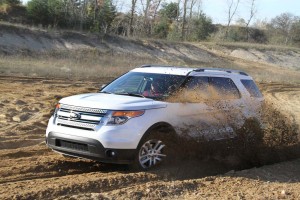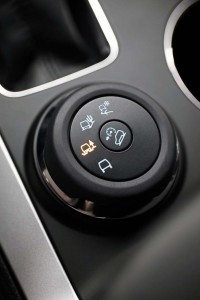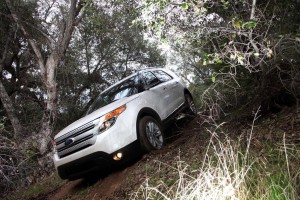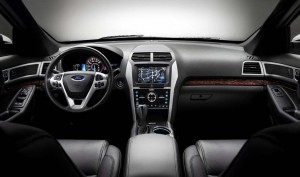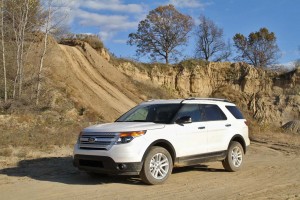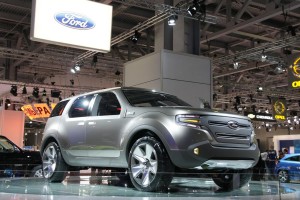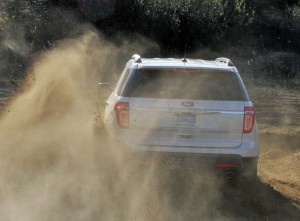Few products have dominated the market like the original Ford Explorer. It was the poster child for the light truck boom of the ‘80s and ‘90s, as millions of Americans traded in their sedans, coupes, wagons — and later, their minivans — for sport-utility vehicles and pickups.
At its peak, the Explorer was racking up sales of as much as 445,000 a year, making it a single nameplate franchise bigger than brands like Subaru, Mazda and virtually every one of the German marques. But for Ford, the good times couldn’t last. And whether it was due to the Firestone/Explorer rollover debacle or simply shifting trends – as crossovers began to overtake classic SUVs – Explorer sales took a sharp tumble soon after the start of the new millennium.
Through the end of November, Ford has sold just 51,000 copies of the outgoing Explorer. But the maker is far from ready to write the old workhorse off. Anything but. The 2011 model is getting ready to roll into showrooms and it justifies the term “all-new” better than most launches we’ve seen in recent years. It also offers the possibility that a new generation of buyers may soon discover the Explorer name – while past owners will be drawn to the showroom to check out what is arguably the best offering in its segment.
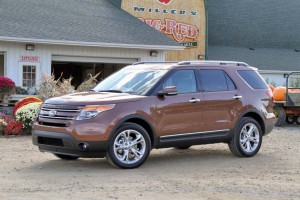
With the 2011 remake of the Explorer, Ford tries to balance traditional SUV capabilities with the advantages of a crossover.
The 2011 Ford Explorer is quite literally an all-new vehicle from the ground up, the automaker making the significant – if risky – decision to switch from a classic body-on-frame design to a car-based crossover. The new version sacrifices a bit of towing capacity and off-road capabilities – though only the most extreme users, those who typically didn’t turn to Ford, anyway, will care. The trade-off yields better mileage, improved comfort and handling, and when paired with an assortment of new safety and creature-comfort features, makes the latest-generation a must to consider for both SUV and crossover buyers.
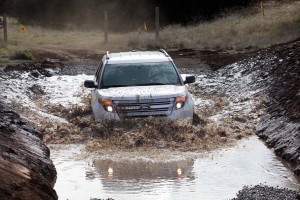
You won't take on the toughest off-road trails but the 2011 Ford Explorer is still quite capable off-road.
Ford designers struck a careful balance with the styling of the 2011 Explorer. It maintains the classic SUV shape, though it’s a bit more poised and well-balanced, with a hint of the 2008 Ford Explorer America concept vehicle that signaled something significant was coming. The new model adopts the new 3-bar Ford standard grille, albeit one that’s designed to say “rugged.” The goal was not to create a “cute-ute,” or extreme crossover, ala a Nissan Murano. What you see is a Ford Explorer, albeit one with a decidedly more modern shape.
And a larger one, at that. The 2011 Ford Explorer is four inches longer, nose-to-tail, and five inches wider. Ground clearance, meanwhile, holds roughly the same as before, at about 8 inches. In terms of comfort, that translates into an especially roomy vehicle, with plenty of cargo capacity, as well. Notably, the new Explorer gets a third row and capacity for seven passengers.
The switch to a crossover platform — one shared, in its fundamentals, with the latest Ford Taurus – did require some sacrifice. Towing capacity is down from 7,250 pounds to an even 5,000, which should impact a modest number of potential buyers. It’s more difficult to say if anyone will notice or care that the 2011 Ford Explorer can no longer handle an off-road torture test like California’s Rubicon Trail. Serious off-roaders seldom, if ever, turned to Ford for that purpose, preferring the likes of the Jeep Grand Cherokee.
That’s not to say this is a “soft-roader.” Anything but. During an afternoon out at Ford’s Romeo, Michigan Proving Grounds, we flogged the 2011 Explorer as hard as just about any serious owner would, tackling roller-coaster like plunges and deep sand, ruts and mud. There were several things that gave Ford engineers the confidence to put us behind the wheel. The basic all-wheel-drive system on the new Explorer is, for starters, as competent as we’d expect, and put the torque right where it was needed, time and again.
What’s missing is the low-range gearing commonly found on classic off-roaders. Instead, there’s the new Terrain Management Control system borrowed from the Land Rover brand that Ford sold off in 2009.
TMC is, in a word, uncanny. With the simple turn of a dial you can set up the 2011 Ford Explorer for specific road conditions, such as snow or sand. The system instantly recalibrates a variety of functions, including throttle responsiveness, gear shifts, and the various brake intervention systems, such as traction control. The difference in vehicle behavior is readily apparent, especially when you’re slogging through a bog that might overwhelm an otherwise competent competitor.
The new Explorer is loaded with a raft of such features, including Hill Descent Control, which uses brake intervention to ensure you nose down event the steepest incline at a manageable speed – as we discovered on a Proving Ground hill so steep we couldn’t see bottom as we came to its crest.
The reality is that most owners will put the 2011 Ford Explorer through much more modest paces, which explains why, according to marketing director Amy Marentic, the goal was to create a four-wheeled “decathlete,” a crossover/SUV that handled a wide range of activities with aplomb. There’s a subtle mindset difference here. In decades past, Detroit makers like Ford were willing to deliver products that did reasonably well when facing a variety of challenges. With the 2011 Explorer remake, Ford set out to be best-in-class in as many activities as possible.
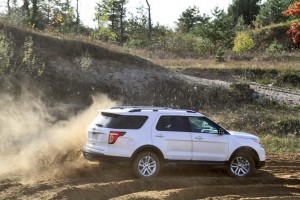
Terrain Management Control helps the 2011 Ford Explorer cut through even the roughest road conditions automatically.
Part of the challenge was to deliver solid competence, off-road, without sacrificing on-road manners. To test that, we headed out on one of the Proving Grounds’ high-speed courses, one that also delivered a few surprises along the way, including some serious whoop-de-doos that nearly sent us flying off the pavement when we tried out the all-new 2011 Jeep Grand Cherokee that Ford made available.
Poise is the first word that comes to mind when describing the new Explorer’s on-road manners. Traditionally, the Ford SUV has been a heavy and ponderous product. Though substantial bigger, the 2011 Explorer feels more compact, composed, nimble. Its steering is precise and one of the nicer executions of electric power assist we’ve experienced.
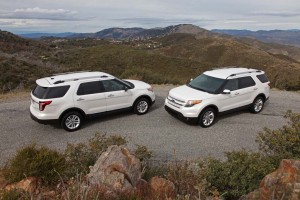
Though bigger - and now equipped with three rows - the 2011 Ford Explorer gets a 25% bump in fuel economy.
One of the questions we had heading out for the afternoon drive was how the 2011 model’s new 3.5-liter V6 would perform under pressure. Consider that it is serving as the replacement for the beefy old 4.6-liter V8. Now, we had already come to respect the new 6-banger which, in passenger car form, is doing such a good job powering the 2011 Ford Mustang. But an Explorer is a very different – larger and heavier and less aerodynamic – beast. We needn’t have worried.
Under the hood of the 2011 Explorer, the new engine is down-rated, just slightly, to 290 horsepower – also a wee bit less than the old V8’s 292 hp – and 255 pound-feet of torque. That’s more than enough for even the heaviest loads. Better yet, you’ll get about 25% better mileage than with the old model, 17 miles per gallon in the city, 25 on the highway, with a combined rating of 20 mpg. The old model got 14/20 in front-drive configuration, 13/19 with an all-wheel-drive powertrain.
Another critical target for the Explorer development team was the interior. The old Explorer was loaded with tacky plastic knobs and switches, aged displays and acres of unimpressive plastic panels. The new 2011 ute nudges into luxury territory with a level of refinement that could give more upscale competitors – never mind mainstream brands, such as Chevrolet, Toyota or Honda – some serious concerns.
The engineers clearly paid attention to ergonomics, placing everything a driver might need within easy reach – either on the IP or the steering wheel – but the material choices are far more elegant and appealing.
Do today’s motorists remember the rollover crisis of a decade ago? It’s hard to say whether that might have any impact on buying decisions – but Ford isn’t taking any chances. The maker’s primary targets for the 2011 Explorer also included safety leadership. And you’ll find all the features you might expect, from electronic stability control to the aforementioned Hill Descent Control.
But Ford also chose to give the new Explorer a number of critical safety first, including center row airbags that come equipped with built-in airbags. In a crash, these new-style bags burst out of the webbing of the shoulder strap and, Ford claims, should reduce injuries to children and elderly passengers.
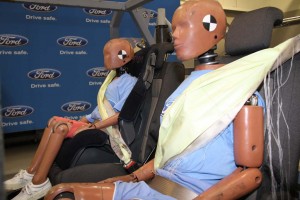
Ford introduces a new inflatable seatbelt on its 2011 Explorer, designed to reduce injuries to both children and elderly passengers.
The other breakthrough is Curve Control. It’s similar to Stability Control but is designed to immediately slow down and stabilize the Explorer should a driver charge into a corner to aggressively. Among other things, it can shave 10 mph off the vehicle’s speed per second by autonomous use of the brakes.
The 2011 Ford Explorer gets all the high-tech systems Ford is promoting so heavily, these days, including Sync, MyTouch and MyKey. Kudos, as well, for the decision to drive down the price of onboard, screen-based navigation to $750, a notable shift from the absurd premiums the industry has traditionally charged – but still well above what many motorists are paying for even mid to high-grade aftermarket systems.
The 2011 Ford Explorer comes to market at a critical time. After crashing in 2008, sales of SUVs have rebounded – though demand has made a major shift from traditional utes to crossover-style vehicles. Fuel prices are again nudging $3 a gallon, around the country, and could influence much of what happens in the 2011 model-year and beyond.
With its better mileage and its focus on safety, Ford has anticipated market trends well. But it has also done a good job of developing that sheet metal decathlete, and the 2011 Ford Explorer is competent – or better – in everything it does. The new model isn’t likely to come close to the sales numbers of Explorers past, but in today’s crowded market it is the model to consider, whether you traditionally focus on domestics or imports, SUVs or CUVs.

